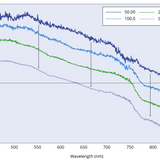Beer Lambert Law

The Beer-Lambert Law is a fundamental principle in spectroscopy. Optical USB spectrometers can quantify the absorption of light by a sample. Using the Beer-Lambert law, you can use these absorbance measurements to easily measure and monitor the concentration of different materials within a solution.
Beer-Lambert Law Principle
The Beer-Lambert Law, also known as Beer's Law, describes the relationship between the concentration of a substance in a solution, the path length of the sample, and the absorbance of light by that sample. It is mathematically represented as:
Where:
- A = Absorbance
- ε = Molar absorptivity (or molar extinction coefficient)
- c = Concentration of the absorbing species
- l = Path length of the sample
The molar absorptivity (ε) or molar extinction coefficient is a substance-specific constant that quantifies its ability to absorb light. This coefficient is determined experimentally.
Beer's law provides a fundamental understanding of how light interacts with matter. It is an indispensable measurement in various fields, including chemistry, biology, and environmental science.
Beer-Lambert Law Applications in Spectroscopy
-
Measuring Solution Concentration
Optical spectrometers or spectrophotometers are widely used for quantitative analysis in chemistry and biology. By utilizing the Beer-Lambert Law, spectrometers can accurately determine the concentration of a specific substance within a sample.
-
Calibration
Calibration is critical for the operation of optical spectrometers. The Beer-Lambert Law provides the foundation for concentration measurement calibration procedures. By establishing a calibration curve using known concentrations of a substance, users can relate absorbance to concentration directly, ensuring the accuracy of subsequent measurements.
-
Improving Spectroscopy Measurements
For various spectroscopy measurements, choosing the optimum path length and sample concentration is crucial. From the Beer Lambert law, the longer the path length or the higher the sample concentration, the higher level of absorbance. Longer path lengths and more concentrated solutions can increase measurement sensitivity, but will decrease signal strength. Users must carefully choose the correct path length and concentration, to optimize signal intensity.
Summary
The Beer-Lambert Law provides a framework for quantitative analysis (such as measuring sample concentration), spectrometer calibration, and signal optimization in many spectroscopy measurements. Beer-Lambert Law serves as the foundational principle that underpins many precise measurements that can be taken using simple optical spectrometers.
USB Spectrometer

Learn More
In absorbance spectroscopy (also known as absorption spectroscopy), a USB spectrometer measures the amount of light absorbed by a sample as a function of wavelength. This can provide important information about a samples molecular structure, concentration or optoelectronic properties.
Read more... Negative Absorbance: Can Absorbance Ever Be Negative?
Negative Absorbance: Can Absorbance Ever Be Negative?
In general, you should not be measuring negative absorbance values for any sample.
Read more...